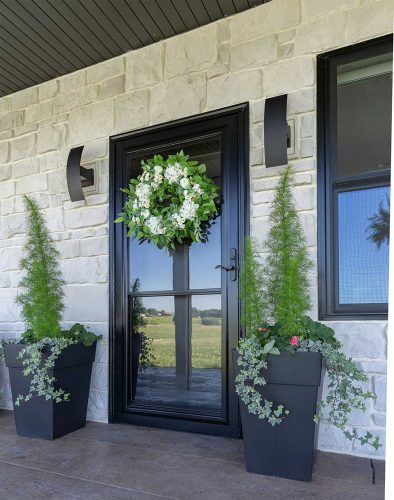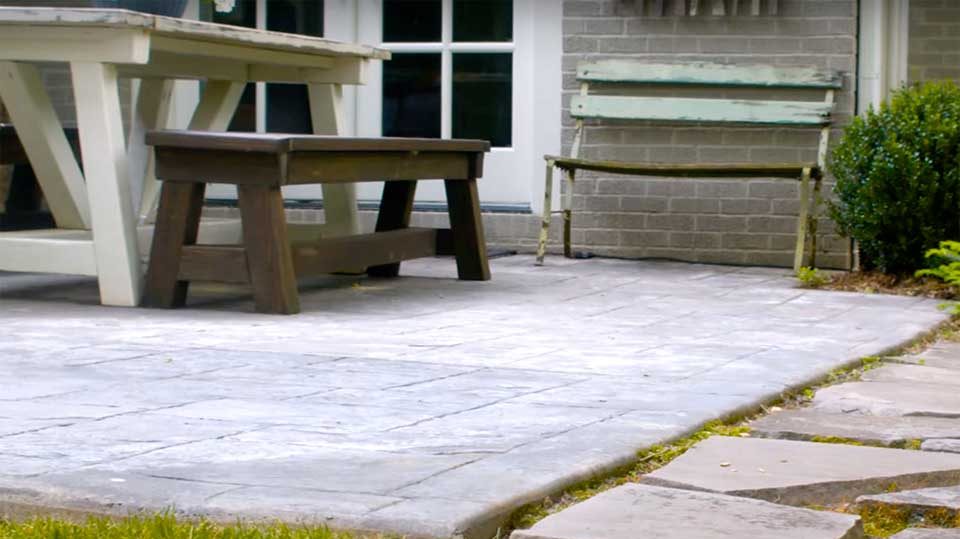Want to live your best backyard life? Experts say outdoor flooring can help you do it.
“Outdoor flooring can keep grass healthy by providing a solid path over high-traffic areas and define areas of your yard for different uses,” says landscape designer Doug Scott of Redeem Your Ground. “However, as with interior decorating decisions, the materials you select can impact how you can use those spaces. And because you’re outside, there is Mother Nature to consider,” he says.
To help homeowners make smart outdoor flooring decisions, Scott has partnered with lawn care equipment manufacturer, Exmark, to offer these insights:
- Moss and other “steppable” living ground covers are perfect for areas with minimal foot traffic, such as shady retreat spaces. The major concern is your yard’s ecosystem. If growing conditions are right, it’s incredibly low maintenance. But when conditions aren’t favorable, it can become a maintenance nightmare. Before making any purchases (costs can vary widely), research if your yard can support this type of organic flooring.
- Mulch is an affordable option that keeps outdoor spaces looking natural. Mulch can be used to decorate landscape beds, and as flooring for pathways, play areas, and dining or living areas. While maintenance is low, mulch will need to be replenished periodically as colors fade and the elements wear it down.
- Aggregates include crushed granite, pea gravel and slate chips. Aesthetically versatile, cheap, and easy to install and maintain, aggregates add a natural look, and make a great option for areas with drainage issues. Because they tend to get worn down or washed away, you’ll need to replenish them occasionally or build a border with stone or brick around them.
Before moving forward, consider that pea gravel is great if you want a softer flooring option, but note that its give can create unstable footing. And, if you have young kids, you might want to avoid aggregates entirely.
“I don’t think I know a kid under age 12 who can resist the temptation to pick up a handful of gravel and throw it,” says Scott.
- Wood flooring is incredibly versatile. It can be cut, customized, painted and stained to fit any style and space and provides a smooth, level surface for entertainment and furniture. The type you choose should depend on your budget and how much maintenance you’re willing to do. Manufactured wood can be expensive, but thankfully requires very minimal maintenance. Natural wood, on the other hand, requires regular staining and sealing.
- Concrete: If you’re looking for a flat, stable surface, concrete is the best choice on the market. While it might seem less chic, it can always be beautified with stains and stamp patterns mimicking brick or stone. While fairly low-maintenance, concrete is prone to cracking, and stamped concrete will need to be sealed periodically. Those repairs can become annoying and expensive down the line.
“If your outdoor space is above tree roots or areas prone to settling, concrete is probably not the right choice for you,” says Scott.
- Stone: Both natural stone and manufactured pavers are durable and a great way to transition from formal to natural in your yard. Natural stone is generally the most expensive outdoor flooring choice, but its durability and versatility makes it well worth it. Manufactured pavers come in a variety of colors, shapes and sizes, and have the added benefit of affordability. While both options require periodic sealing and staining to retain their appearance and durability, if done right, they’ll last you many years.
Everything You Need to Know About Storm Doors

Like many home elements, there’s a lot to consider when selecting storm doors. By weighing your style preferences and security needs, and by determining what add-ons your household can benefit from, you can make a decision you won’t regret.
“Storm doors provide insulation, curb appeal, and weather protection for the entry door, but they are not one-size-fits-all,” says Brandon Morris, entry and storm door product manager at ProVia, a manufacturer that carries several brands of customizable aluminum storm doors. “Before making a purchase, first determine your needs and style preferences.”
To help homeowners make sense of their options, ProVia is offering this round-up of essential factors to consider:
Construction: To reap the maximum benefits a storm door can provide, take thickness and construction into consideration. Those offered by ProVia all feature an aluminum wall thickness 20 percent greater than industry standard, to provide greater protection to your entry door, along with stability and durability for long-term use. Most brands they carry also have multi-hollow construction, which translates to greater strength and security than standard storm doors.
Style: Storm doors are not always just functional. Certain manufacturers understand that they are a home element that can boost curb appeal, too. Decorative storm doors come with options like beveled glass, stained glass, and privacy glass, adding visual appeal, and a unique artistic statement where you least expect. Different colors and multiple options in hardware styles and finishes allow the storm door to blend in with your exterior design, whether that’s traditional and understated or ultramodern and eye-catching.
Glass: The type of glass you choose can maximize energy efficiency. Low emissivity (Low-E) glass doors, for example, have a thin, invisible coating that reduces infrared and ultraviolet light coming through the door glass. In winter, Low-E glass lets radiant heat pass through, but doesn’t allow it to come back out, for a cozier interior. And in summer, it helps keep heat out. Low-E glass also features UV protection that can prevent fading of items inside your home.
Storm doors with removable glass panels and retractable screens enable airflow and crucial ventilation between the storm and entry doors, while letting the design of the entryway shine.
Accessories: Accessories can create additional functionality for your storm door. Have a furry friend who needs regular outdoor access? Consider a doggie door so it can come and go as it pleases . Some manufacturers offer this option in multiple sizes to fit your pet’s needs. No streetside mailbox on your property? Add a mail slot to your storm door.
Other optional features, such as a piano hinge and bottom expander, and an easy release closer, can help your storm door operate more smoothly, while ensuring it’s custom-fit to eliminate drafts.
Keep Your Home Cozy With These Upgrades
When the temperatures drop and the precipitation turns cold, efficiently keeping your home cozy and warm is likely a top priority. As you make home upgrades this fall, be sure to use materials designed to withstand extreme weather events and that help manage indoor climate control. Doing so will mean greater comfort and more affordable energy bills.
Roofing: As your first defense against all kinds of weather, your roof sustains a lot of wear and tear. Consider prioritizing durability, strength and weather resistance in a new roof by opting for metal. You can get a classic appearance with this material, thanks to updates in roofing technology.
Siding: Is your home ever drafty or chilly when the temperatures drop and the wind kicks up? The culprit may be insufficient insulation. Keep in mind that most wall insulation is placed only between the studs, and wall studs make up to 25 percent of the wall surface of an average home. You can fill in these insulation gaps with insulated vinyl siding that’s been tested and proven to increase the R-value (a measure of a material’s resistance to heat flow) of an exterior wall.
Windows: Windows are a common point of heat transfer, and as such, they play a huge role in the comfort of your home. It’s not often that you have to purchase windows for your home, but when you do, you’ll want to ensure that they deliver the best in energy efficiency and comfort. ENERGY STAR-certified windows will help keep your home warm in winter (and cool in summer).
Interior Décor: You may not think about your interior decorating choices as something that could potentially improve your home’s energy efficiency, but many such updates will not only make your home look more cozy, they’ll actually help keep it warm. Thick area rugs are a good place to start, as they provide insulation underfoot. Likewise, cellular shades or Roman shades can help stop heat transfer around windows, and wall tapestries or fabric-like wallpaper can provide a touch more insulation on walls.
Fall Maintenance Checklist to Keep Your Home in Tip-Top Shape
Fall is in the air, which means there is a lot to get done around the house before the cold weather comes. While fall maintenance can feel daunting, following these tips will simplify the process, so you can feel confident that your house is prepared for changing temperatures.
Fall Furnace Check. Before winter arrives, ensure your heating system is in working condition and safe to use. Turn off the furnace first and then clean the vents, check for cracks or rust and swap out the dirty filter for a clean one. If it’s been a while since your furnace has been maintained, it may be time to schedule a professional visit.
Gutter Clean Out. While the fall foliage is beautiful, it can quickly clog gutters and cause water backups and flooding. Put on heavy-duty work gloves and remove debris near the downspout and work your way to the other end. As you clear away the leaves, easily repair broken or cracked pipes with strong T-Rex Tape. Unlike ordinary duct tapes, this strong tape is built with intense holding power for long-lasting repairs, and its aggressive double-thick adhesive ensures it sticks to rough, dirty surfaces through all weather types and temperatures.
Trim Your Trees. Cut bushes and trees hanging over the driveway or roof to prevent limbs from falling during snowstorms this winter. Focus on trimming any dead or drooping branches, as these are the ones that are most likely to cause damage.
Stop the Drafts. Insulating the home helps you stay warm and save money on energy bills. Identify trouble spots where drafts occur and use weather strip seals, like those from Duck brand, to effectively seal these gaps.
Secure the Perimeter. Slips and falls can occur when steps and walkways are covered with ice and snow. Install proper outdoor lighting to illuminate these areas and to help prevent accidents. If you have steep or uneven wood or concrete steps, apply T-Rex Extreme Tread Tape to improve traction on the surface. This quality tape is made with a multi-layer grit embedding process for long-lasting wear and features a stronger adhesive bond than standard anti-slip tapes.

 Like many home elements, there’s a lot to consider when selecting storm doors. By weighing your style preferences and security needs, and by determining what add-ons your household can benefit from, you can make a decision you won’t regret.
Like many home elements, there’s a lot to consider when selecting storm doors. By weighing your style preferences and security needs, and by determining what add-ons your household can benefit from, you can make a decision you won’t regret.








